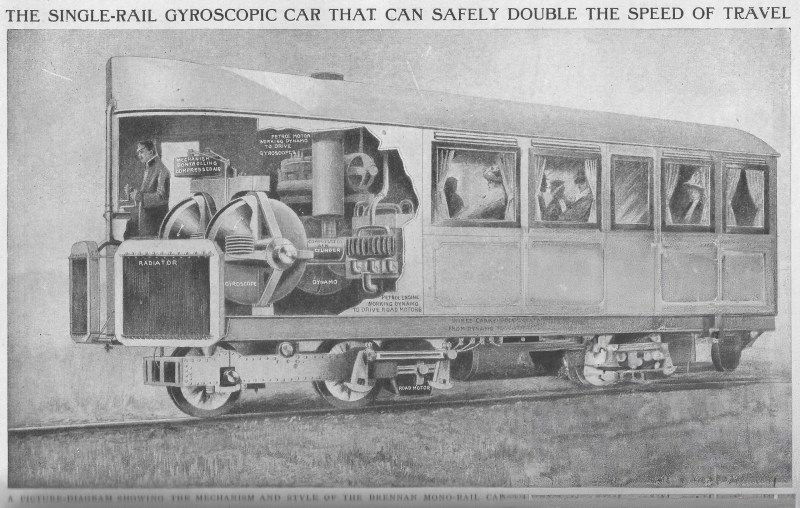
Everyone who has ever handled a spinning gyroscope found themselves likely mesmerized by the way it absolutely maintains its orientation even when disturbed. Much of modern technology would be impossible without them, whether space telescopes or avionics. Yet during the early 20th century a much more radical idea was proposed for gyroscopes, one that would essentially have turned entire trains into gyroscopes. This was the concept of the Gyro Monorail, with Louis Brennan being among those who built a full-sized, working prototype in 1910, with its history and fate covered in detail by [Primal Space], along with an accompanying video.
At first glance it may seem rather daft to have an entire train balancing on a single rail track, using nothing but gyroscopic forces to keep the entire contraption level and balanced even when you feel the thing should just tip over. Yet the gyroscopic system that Brennan created and patented in 1903 turned out to function really well, and reliably kept the train on its single track. Key to this was the use of two gyroscopic wheels, each spinning in an opposite direction, with a pneumatic system linked to a gear system between the two wheels that used the gyroscope’s precession in corners to quickly establish a new balance.
Despite this success, investors were unconvinced, and regular trains were already firmly established, and the system would also require that each car had its own gyro system. Even so, the idea of the gyro monorail never truly died, as evidenced by the recently created German MonoCab-OWL project. This targets converting single-rail sections into dual-rail, bi-directional service with no infrastructure investment required.
Thanks to [Stephen Walters] for the tip.
















O.K. Single points of failure make me nervous, I’d really want two gyros operating independently of one anther per rail car for a passenger train. That said, the MonoCab-OWL project looks really cool. The idea of using a single traditional rail for an up and down line is pretty slick.
Rail reuse would help passenger rail thrive.
https://youtu.be/dmpyV4Yf8b0
Traditional rail also has a single point of failure: if one of the rails fail, the train will derail and probably crash.
Reliability is key in having a single point of failure: chances that a passive piece of metal lying on the ground fails are much smaller than chances of a heavy lump of metal spinning at several thousands rpm mounted in a complex hinge, bar and gear system fail.
Fascinating, and a story close to my heart.
When I was in grad school, we had a large teaching gyroscope on a poratble stand. I played with this gyroscope quite a bit, trying to explain the gyroscope’s right angle precession to myself. It wasn’t intuitive, but I knew it wasn’t magic.
I finally hit upon the idea of imagining the molecules of the two opposite rotor edges as two streams of liquid water flowing in opposite directions. Applying a pair of deflection forces to the two streams in opposite and complementary directions resulted in the equivalent of the right angle precession behavior the gyroscope exhibits, and no magic involved. It was a very satisfying thought experiment.
One of those inventions that is obviously impractical for general use, like the monocycle where you ride inside one giant wheel and if you hit the breaks you start doing the hamster wheel thing
‘brakes’ … But you just might break something anyway :) .
Cool article. A lot of neat things have been invented over time … One problem I see if something causes the gyros to stop (run out of gas?) while rolling down the track….. One would need a device like a bike’s kick stand to deploy and hold upright.
The bidirectional MonoCab-OWL thing seems neat if you’re repurposing the usual two rails to do a new job. Otherwise you’re taking up the whole railroad even if you only use one of the rails. I do appreciate the approach, though, of making things which do what they do because it’s in their nature to do so. Like a coin sorter that goes based on size rather than sensors and servos – the physical mechanics of the situation say a gyro must precess, and so it does.
That said, there’s also been gyro-cars. And a point of commonality between ultra-economy competitions and bicycle top speed attempts is that putting a fairing around a recumbent human on two bicycle wheels is just about the most efficient way to move them quickly – you can do it with more wheels, but with two you can be even more streamlined and efficient. I imagine that as you’d need something to deploy for parking anyway, you don’t strictly need a gyro. And, well, yes if you ride a motorcycle you’re used to not letting it lean over far enough at low speeds to drop it, but the heavier it is compared to you, the more annoying that is. That said, you can’t set your feet down if you’re fully enclosed and I imagine the gyro could also help stabilize against crosswinds and such. Could be neat, even if I don’t know whether it could make up for its own weight and energy cost. I’m thinking at larger sizes, which we’d only ever use 3-4 wheels for, it might.
I have seen the video two months ago and got a “deja vu” feeling. Same when the F15 secret microcontoller article popup few days ago. And this happends way to often. I’m roaming the web/yt to long for my health good.
“it may seem rather daft to have an entire train balancing on a single rail track,”
All the train, half the track. Save money where you can.
It could have had niche uses as temporary field railway systems for agriculture or mining. Bridges could be as quick and simple as a tightrope, just don’t run out of gas half way across!